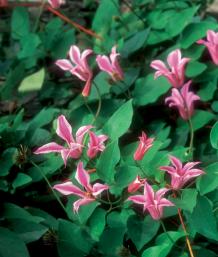
Photo/Illustration: Bill Johnson
Almost everyone is enchanted by a clematis, and I am no exception. When I first started my decades-long love affair with this bewitching vine, I was awestruck by the sheer beauty and grandeur of the big, bold, and beautiful hybrids.
But people are often too blinded by the glamorous to see the graceful. Such is the number of species and cultivars in this genus that we could easily devote the sum of our gardening passions to this vine and never move beyond the large, star-shaped blooms of pink, purple, and white. But the sheer diversity of Clematis merits further exploration.
When I discovered the dizzying selection that clematis offers, my infatuation intensified. Flower shapes can resemble bells, lanterns, tulips, stars, saucers, or even little elf hats. The blooms can be as tiny as 12 inch long but are produced with such profusion as to create a powerful impression. Their colors include pink, white, red, yellow, and myriad shades of purple. It’s common to find combinations of these colors on one flower. I couldn’t help but be smitten by such captivating plants.
More Reading:
3 Myths About Clematis
Pruning Clematis
Clematis with Everything
From the Plant Guide: Clematis
The following clematis have a color, shape, or size that make them just a bit out of the ordinary. Yet none requires special conditions to grow nor is so obscure that only one specialty nursery sells it. Consider these clematis merely a first step into a world to be discovered, a brief glimpse at the possibilities that exist beyond the large-flowered cultivars. Even if you grow just one, you will be enamored with the elegance it adds to your garden.
‘Duchess of Albany’ features tulip-shaped flowers
‘Duchess of Albany’ (Clematis ‘Duchess of Albany’) is a beautiful clematis impressive for its ability to produce multitudes of pointed, cherry-pink blooms that resemble tulips. It can get 8 to 10 feet tall, so be sure to plant it in a location where it has room to roam. I have mine growing into the hot pink climbing rose ‘Winifred Coulter’. When they bloom together, the combination dazzles.
‘Rooguchi’ is a small but striking vine

On the smaller end of the clematis height spectrum crouches the relatively new Japanese introduction ‘Rooguchi’ (Clematis ‘Rooguchi’). Averaging about 4 feet in height, it is by no means a lightweight when it comes to blooming. It puts on a stunning summer display of bell-shaped deep purple flowers. ‘Rooguchi’ does not attach itself by its leaf stalks. To keep it out of harm’s way (from snails, slugs, and pet attacks), provide it with some type of support. This cultivar’s short stature makes it a great candidate for a container with a decorative obelisk. Or you can combine its blooms with the fabulous clusters of mauve-rose flowers on ‘Anthony Waterer’ spirea (Spiraea japonica ‘Anthony Waterer’, USDA Hardiness Zones 4–9).
Clematis, Clematis spp. and cvs. (CLEM-uh-tis)
Hardiness: All the clematis mentioned in this article are hardy in USDA Hardiness Zones 4 to 11.
Size: Many factors can affect the height of a clematis. Expect most species and cultivars to reach between 6 and 9 feet tall.
Pests and diseases: Stem rot (a.k.a. clematis wilt), powdery mildew, and slugs are common afflictions with clematis.
Conditions: Most clematis prefer full sun, but those varieties with delicately colored blooms do best in light shade. They all enjoy moist, well-drained, slightly acidic soil.
Maintenance: Clematis do not require heavy amounts of fertilizer or water, but they do require a steady supply of both during the growing season. Pruning clematis often causes confusion among gardeners, but be assured that a healthy plant will recover from almost any cuts you make to it.
Think clematis are tricky to grow? Try a viticella
Vines from the species viticella are excellent plants for those who may be faint of heart or are laboring under the impression that clematis is a finicky plant. These plants are noted for their hardiness, vigor, general ease of growing, and resistance to common clematis afflictions like stem rot and powdery mildew. Viticellas can grow in full sun or dappled shade and can take the heat of warmer climates. These vines generally grow 6 to 9 feet tall and tend to produce flowers by the hundreds in late spring and again in fall, if the growing season is long enough.
‘Pagoda’ adds an Asian touch to the garden
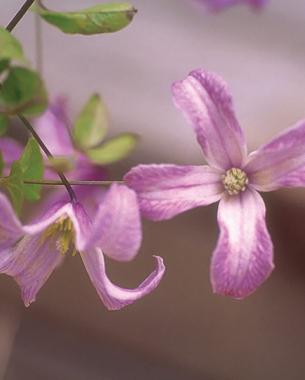
The blooms of ‘Pagoda’ (Clematis ‘Pagoda’) have a profile reminiscent of the roof of a Japanese garden pavilion. This vine’s 1 1/2- to 3-inch-wide, nodding flowers feature a veined, purplish pink inside and a striking purple bar on the outside. I grow mine on a 6-foot-tall obelisk, and after reaching the top, it gently cascades back down upon its lower half. This remingling provides the impression that it has twice as many blooms. It enjoys a full-sun or dappled-shade exposure.
‘Pagoda’ is sometimes sold in this country as C. texensis ‘Pagoda’ because it is a cross between C. viticella and C. ‘Etoile Rose’, a hybrid of C. texensis. I feel it is more of a viticella because it has more viticella blood than texensis blood. ‘Pagoda’ is not herbaceous like the texensis species, and its leaf shape and resistance to powdery mildew are more characteristic of viticella.
‘Purpurea Plena Elegans’ has dazzling double blossoms
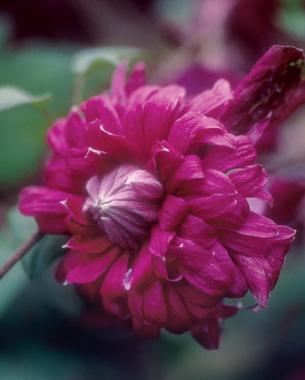
The flowers of ‘Purpurea Plena Elegans’ (Clematis viticella ‘Purpurea Plena Elegans’) are uncommon for a clematis. The elegant blooms form eye-catching, deep magenta rosettes that last for weeks. The double flowers are 2 to 2 1/2 inches wide and appear in late spring by the hundreds. While it can still reach the 6- to 9-foot-tall range of most clematis, it tends to stay on the smaller side. Feel free to plant it in a large container or allow it to grow into a large shrub such as a hydrangea.
‘Little Nell’ is a tough vine with subtle beauty

For a delicate touch but with large, 2- to 212-inch-wide flowers, try ‘Little Nell’. At first glance, one might think that this dainty clematis is so frail that it would vanish with the slightest gust of wind. Yet ‘Little Nell’ (Clematis viticella ‘Little Nell’) turns out to be a real spitfire. Year after year, this vigorous vine will reward you with countless numbers of backward-curving creamy white blossoms edged in a pastel purple. This clematis tends to reach anywhere from 6 to 9 feet tall. Grow it in full sun or dappled shade. To truly enjoy it, I suggest you plant it close to a path or bench; otherwise, its subtle beauty may be lost. A magenta-flowered rose such as ‘Gertrude Jekyll’ makes an excellent backdrop and an exciting contrast.
Clematis pitcheri boasts a deluge of delicate blooms

We are all attracted to huge blooms, but tiny flowers have the same ability to stop us in our tracks. Clematis pitcheri produces charming little blossoms in such abundance that they force you to pause and admire them. This prolific bloomer can provide you with three to four months of hundreds of delicate, 1 1/2-inch-long dark purple bells. In my garden, I count on C. pitcheri for a full summer of enjoyment. Though it remains deceivingly short for its first few years, this vine can reach 10 or 15 feet tall. Train C. pitcheri to go where you want because once it takes off, it can run rampant if you don’t keep an eye on it. This native species grows in moist locations in the wild, but it can also tolerate some drought.
‘Bill MacKenzie’ is the best yellow clematis
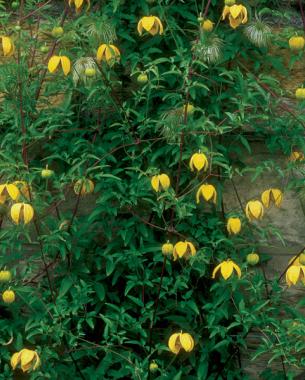
Yellow is an uncommon color for clematis, and the best of this small bunch is ‘Bill MacKenzie’ ( Clematis ‘Bill MacKenzie’). The flower buds of this cheerful clematis look like tiny yellow paper lanterns. Once they pop open, they transform into 2- to 3-inch-wide parachutes. Ordinarily, I don’t allow seed heads to form on my vines, preferring to deadhead to promote subsequent blooms. With ‘Bill MacKenzie’, though, I leave the puffy silver seed heads on the plant to use later in my Thanksgiving Day floral arrangement. Unlike the similar-looking Clematis tangutica , ‘Bill MacKenzie’ does not reseed itself everywhere. This vine has the ability to climb to 20 feet high, but in hotter areas, such as Zones 10 and 11, it may only get to half that height.
‘Huldine’ adds grace to any structure
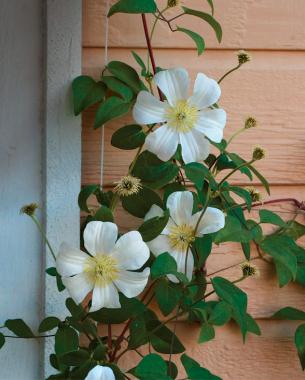
I call Clematis ‘Huldine’ a “clematis for connoisseurs” because it is an excellent choice for those seeking something a little out of the ordinary. Its flowers form graceful, 2- to 4-inch-wide pearly white cups with pinkish bars along the back. The graceful, backward arch of the petals sets it apart from showy, large-flowered hybrids. With its potential 10-foot height, ‘Huldine’ is perfect for adorning an arch. This clematis produces scores of blooms in spring and again in fall. Warmer climates may even see three bloom periods a year. It requires a warm location with plenty of sun.
‘Betty Corning’ displays bell-shaped blossoms
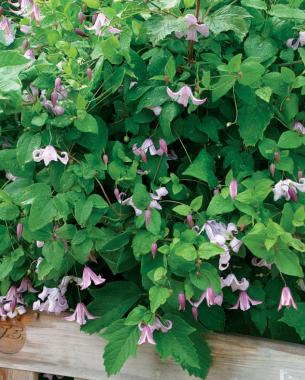
The first American clematis to be cultivated was Clematis viticella ‘Betty Corning’. The flower of this classic clematis forms a delicate, 1 1/2- to 2-inch-long, nodding bell painted soft lavender. Try as I might, I have yet to experience its sweet fragrance. I believe that to encounter its scent you may have to live somewhere colder than my Southern California locale. This clematis generally grows 6 to 9 feet tall and tends to produce flowers by the hundreds in late spring and in fall, if the growing season is long enough. It can take full sun or dappled shade and doesn’t mind the heat of warmer climates.Woven into a tall shrub, the delicate blooms of ‘Betty Corning’ lend a distinct charm to its neighbor.
Clematis crispa has a long season of bloom
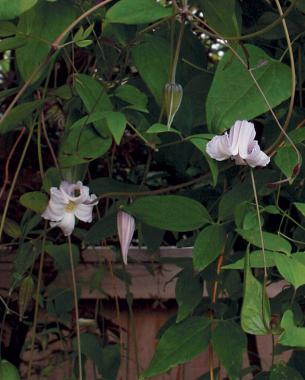
The charming Clematis crispa is probably the clematis closest to my heart because it was the first American species to be discovered. Even without its legacy, I would love it just for its perpetual flowering ability, blooming from April to October in my Southern California garden. In less-temperate areas of the country, the bloom period may not last as long. The petite, nodding heads of C. crispa , no more than 1 1/2 inches long, appear on vines that reach anywhere from 5 to 8 feet high. This vine’s native habitat is wet woods and marshes, but it thrives equally well in drier locations with regular watering. When selecting a home for C. crispa , keep in mind that its slender stems are ideal for growing into a subshrub. Doing so reduces the risk of breaking the delicate vines. I grow mine just outside my living-room window into the purplish blue flowers of a Queen’s wreath ( Petrea volubilis ).
Fine Gardening Recommended Products

Planting in a Post-Wild World: Designing Plant Communities for Resilient Landscapes
Fine Gardening receives a commission for items purchased through links on this site, including Amazon Associates and other affiliate advertising programs.

Pruning Simplified: A Step-by-Step Guide to 50 Popular Trees and Shrubs
Fine Gardening receives a commission for items purchased through links on this site, including Amazon Associates and other affiliate advertising programs.

Lee Valley Garden Obelisks
Fine Gardening receives a commission for items purchased through links on this site, including Amazon Associates and other affiliate advertising programs.

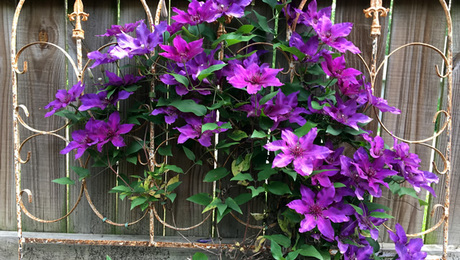
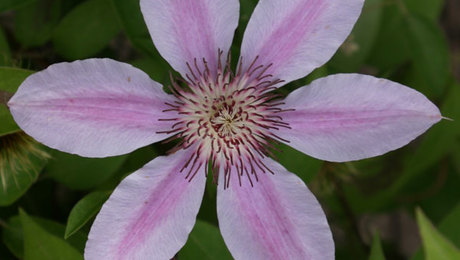
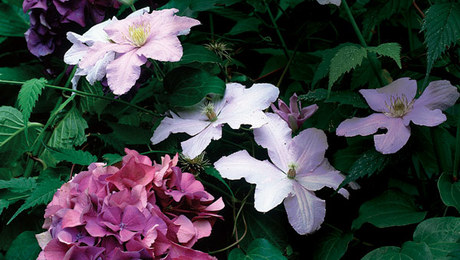
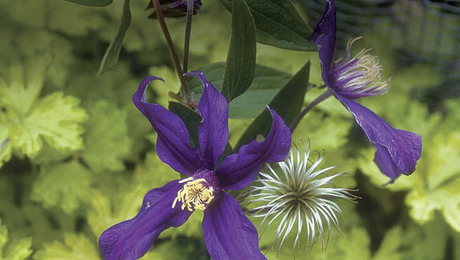













Comments
terrific Henrii with masses of two leaf babies below. could they be offspring?
Log in or create an account to post a comment.
Sign up Log in